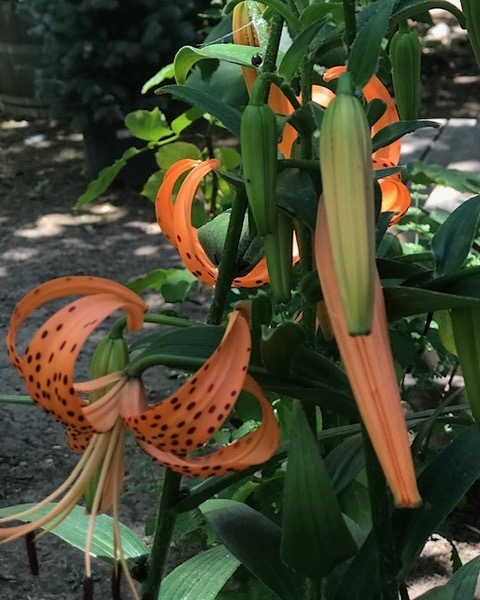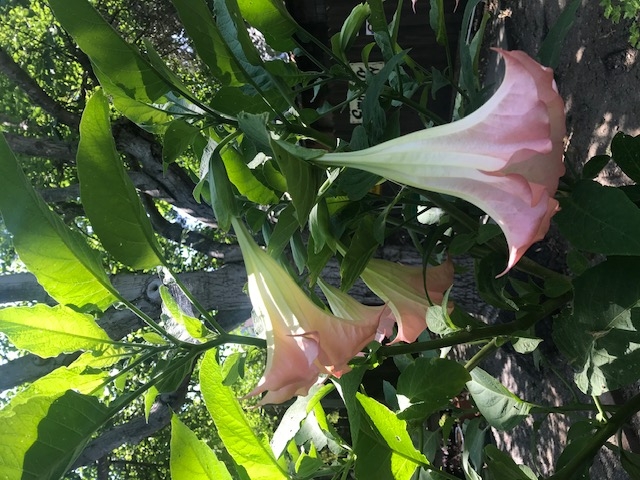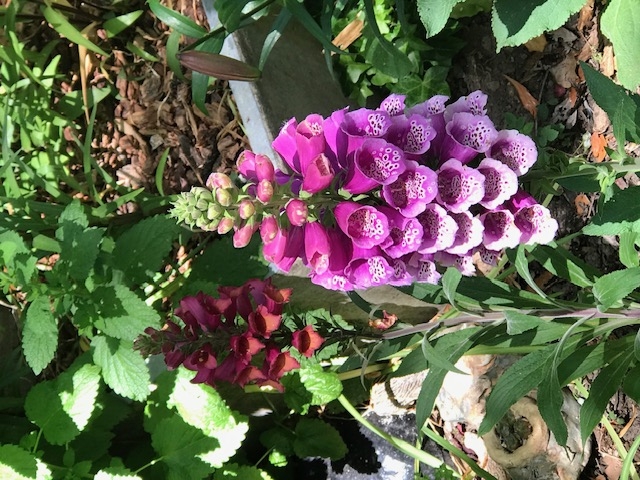During the summer of 2023, I did a lot of traveling, and my garden didn't get the oversight it needed. I say “oversight” because my yard has a mind of its own.
Just before I took off, I looked around the place and noticed a flash of red stems near the back. “The amaranth has come back! Won't the birds be happy!” I thought and then rushed to the airport.
When I returned a month later, what had appeared as amaranth to my nearsighted eyes revealed itself to be highly poisonous pokeweed, now 12 feet tall.
I have written in the past about poisonous plants in my yard—calla lilies, foxgloves, and my favorite, brugmansia (which is hallucinogenic as well as highly toxic). While acknowledging that these plants are dangerous, I have always added the lighthearted comment that the plants taste so terrible that no rational person--or dog, or cat—would ingest them.
Lately I have been rethinking that assertion. Dogs, cats, and babies, plus adults wanting to experience a state of altered consciousness, are not overburdened with common sense. Oh, and there is another reason. I will be a grandmother any day now.
I called up Silverado Veterinary Hospital and asked the receptionist if anyone had ever brought in a pet that had been poisoned by a landscape plant. She answered that they did get the occasional cat that had eaten a lily.
Calla lilies—or any lily and most bulbs—can cause acute gastric distress and organ damage. What's tempting about a lily? Cats might like the taste of the pollen or be attracted to the flower's fragrance. The vets at Silverado can save a cat that has eaten a poisonous plant, but I began to rethink my cavalier attitude. (Note: Dogs don't seem to be attracted to lilies, but cats really like them.)
Most plants that are toxic to pets are also toxic to humans, but symptoms are worse in dogs, cats, and young children because of their smaller size. Most of these plants cause vomiting and diarrhea, resulting in dehydration, which is much more dangerous for small creatures.
There are many toxic plants, but these are the most common: aloe, anemones, chrysanthemums, crocus, cyclamen, daffodils, daisies, hyacinths, jade plants, lilies, lilies of the valley, rhododendrons and tulips. Sago plants are probably the most dangerous. Just one or two seeds can poison you.
Plants that are toxic but rarely ingested by pets are brugmansia, castor bean (source of ricin), daphne, foxglove, jimson weed, nicotiana, pokeweed and yew. You can see the fine line between a helpful pharmaceutical and a risky substance in this list. Yew is used in chemotherapy to cure cancer, and foxglove is a source of digitalis, a heart medicine.
That pokeweed in my back yard is going to have to come out. The birds love it, and I doubt that my dog or the visiting cats will eat it. However, the berries are shiny and black, borne on cherry-red stems with green leaves, making the plant eye-catching. I can imagine a child wanting to eat the berries, especially because they have a syrupy scent. Pokeweed berries are very toxic.
I also won't replace the daphne that froze last winter, nor will I plant any more foxgloves. Some people fence off their risky plants, but I suspect my grandchild will be the sort of person who will think a fence is to be climbed over, so I will have a plant giveaway instead. I will be thrilled to rip out the anemone, which hasn't done well here since the summers have become so hot.
Fertilizers can be dangerous, too. When I planted my tiger lilies, my new poodle puppy was anxious to help. She really liked to eat the bone meal that went into the planting hole with the bulbs. I stopped that behavior by covering the tiger lily bed with mulch and, on top of that, wire mesh. While bone meal isn't poisonous, it will clump into a ball in the pet's stomach. The resulting blockage is expensive to remedy.
The UC Davis Veterinary School has a Toxic Plant Garden that is well worth a visit. All the plants are clearly labeled. It is a surprise to see so many common landscaping shrubs, such as oleander, in this collection.
You may ask, “What can I plant without killing small animals and children?” You can plant fruit, vegetables, herbs, wildflowers, California natives and roses, just for a start. So, no need to feel deprived. I have noticed lately a horticultural fad of growing a goth-style garden filled with plants in the poisonous nightshade family. It's an amusing conceit, but a poisoned child or pet is no joke.
Workshop: Join UC Master Gardeners of Napa County for a workshop on “Soils, Compost and Mulch” on Wednesday, October 9, from 6:30 pm to 8:30 pm, at the Pelusi Building, 2296 Streblow Drive in Napa. Pat Costello, the City's water resources analyst, will summarize the eight principles of water-wise landscaping. Master Gardeners will examine local soil types and demonstrate how to improve your soil with aeration, amendments, and mulch. Register here.
Workshop: Join UC Master Gardeners of Napa County for a “Water-Wise Plant Show” on Wednesday, October 16, from 6:30 pm to 8:30 pm, at the Pelusi Building, 2296 Streblow Drive in Napa. Local landscape designers will demonstrate that drought-tolerant is anything but boring. Register here.
Help Desk: The Master Gardener Help Desk is available to answer your garden questions on Mondays and Fridays from 10 am until 1 pm at the University of California Cooperative Extension Office, 1710 Soscol Avenue, Suite 4, Napa. Or send your questions to mastergardeners@countyofnapa.org. Include your name, address, phone number and a brief description.
Attached Images:


